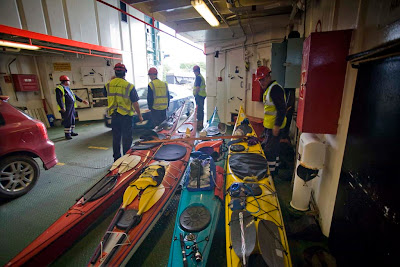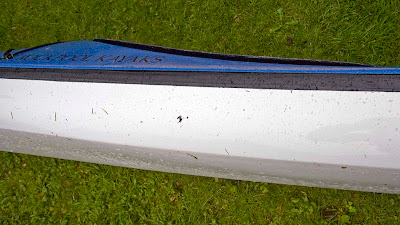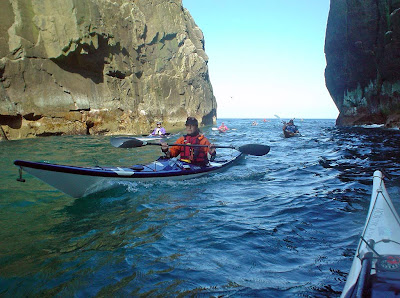
As we crossed the Sound of Jura, towards the Sound of Islay, a force 5 wind was blowing from the north west. The air was very clear and to the north the Paps of Jura heaved above the horizon. However, the wind meant that we would need to plan our sea kayaking adventure carefully. Initial plans to paddle against the tide and head north towards the island of Colonsay were put to one side.

Mair and Billy had met David and myself at Kennacraig, on the west coast of the Mull of Kintyre. We had promised ourselves a trip to Islay for too long, now it was a reality! We were to meet Tony on Islay at Port Askaig. He had already enjoyed a family holiday for a week on the island.

The MV Hebridean Isles docked right on time as we were putting the final bags into the kayaks.

We used trolleys to wheel them onto the car deck. The kayaks travel for £10 return on any Caledonian Macbrayne crossing. Note the strap restraining the kayaks for a windy crossing. Normally they do not bother.

Our excitement mounted as we approached the tiny Port Askaig. It lies at the foot of steep cliffs. Rather I should say lay at the foot of steep cliffs. The port is midway through a 13 million pound redevelopment that has carved a new approach and waiting area from the cliffs (destroying two of the villages few houses) and constructed a new roll on roll off jetty.
Also noticeable is the Islay Severn class lifeboat Helmut Schroder of Dunlossit II. This has been on station since 1997. On 18 December 1991, the previous Thames class boat, Helmut Schroder of Dunlossit, was involved in the dramatic of nearly 50 souls from the Russian fish factory vessel Kartli.

Port Askaig is one of Islay's two ferry terminals. The other is on the south of the island at Port Ellen. Port Askaig is also the terminal for the MV Eilean Dhiura which crosses 0.9km of the Sound of Isla to Feolin on Jura.
We had arrived on Islay!
12/07/2008











































